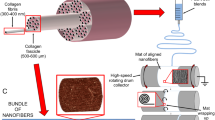Abstract
Laser tissue welding and soldering is being increasingly used in the clinical setting for defined surgical procedures. The exact induced changes responsible for tensile strength are not yet fully investigated. To further improve the strength of the bonding, a better understanding of the laser impact at the subcellular level is necessary. The goal of this study was to analyze whether the effect of laser irradiation on covalent bonding in pure collagen using irradiances typically applied for tissue soldering. Pure rabbit and equine type I collagen were subjected to laser irradiation. In the first part of the study, rabbit and equine collagen were compared using identical laser and irradiation settings. In the second part of the study, equine collagen was irradiated at increasing laser powers. Changes in covalent bonding were studied indirectly using the sodium dodecylsulfate polyacrylamide gel electrophoresis (SDS-PAGE) technique. Tensile strengths of soldered membranes were measured with a calibrated tensile force gauge. In the first experiment, no differences between the species-specific collagen bands were noted, and no changes in banding were found on SDS-PAGE after laser irradiation. In the second experiment, increasing laser irradiation power showed no effect on collagen banding in SDS-PAGE. Finally, the laser tissue soldering of pure collagen membranes showed virtually no determinable tensile strength. Laser irradiation of pure collagen at typical power settings and exposure times generally used in laser tissue soldering does not induce covalent bonding between collagen molecules. This is true for both rabbit and equine collagen proveniences. Furthermore, soldering of pure collagen membranes without additional cellular components does not achieve the typical tensile strength reported in native, cell-rich tissues. This study is a first step in a better understanding of laser impact at the molecular level and might prove useful in engineering of combined collagen-soldering matrix membranes for special laser soldering applications.


Similar content being viewed by others
References
McNally-Heitzelmann KM, Welch AJ (2003) Laser tissue welding. In: Vo-Dinh T (ed) Biomed photonics handbook, vol 39. CRC, London
Bass LS, Treat MR (1995) Laser tissue welding: a comprehensive review of current and future clinical applications. Lasers Surg Med 17(4):315–349
Foyt D, Johnson JP, Kirsch AJ, Bruce JN, Wazen JJ (1996) Dural closure with laser tissue welding. Otolaryngol Head Neck Surg 115(6):513–518
Fried NM, Walsh JT Jr (2000) Laser skin welding: in vivo tensile strength and wound healing results. Lasers Surg Med 27(1):55–65
McNally KM, Sorg BS, Chan EK, Welch AJ, Dawes JM, Owen ER (1999) Optimal parameters for laser tissue soldering. Part I: tensile strength and scanning electron microscopy analysis. Lasers Surg Med 24(5):319–331
Ott B, Constantinescu MA, Erni D, Banic A, Schaffner T, Frenz M (2004) Intraluminal laser light source and external solder: in vivo evaluation of a new technique for microvascular anastomosis. Lasers Surg Med 35(4):312–316
McNally KM, Sorg BS, Welch AJ, Dawes JM, Owen ER (1999) Photothermal effects of laser tissue soldering. Phys Med Biol 44(4):983–1002; discussion 1002 pages follow
Bass LS, Moazami N, Pocsidio J, Oz MC, LoGerfo P, Treat MR (1992) Changes in type I collagen following laser welding. Lasers Surg Med 12(5):500–505
Schober R, Ulrich F, Sander T, Durselen H, Hessel S (1986) Laser-induced alteration of collagen substructure allows microsurgical tissue welding. Science 232(4756):1421–1422
Murray LW, Su L, Kopchok GE, White RA (1989) Crosslinking of extracellular matrix proteins: a preliminary report on a possible mechanism of argon laser welding. Lasers Surg Med 9(5):490–496
Helmsworth TF, Wright CB, Scheffter SM, Schlemm DJ, Keller SJ (1990) Molecular surgery of the basement membrane by the argon laser. Lasers Surg Med 10(6):576–583
Laemmli U (1970) Cleavage of structural proteins during the assembly of the head of bacteriophageT4. Nature 227(5259):680–685
Yahr WZ, Strully KJ, Hurwitt ES (1964) Non-occlusive small arterial anastomosis with a neodymium laser. Surg Forum 15:224–226
Anderson NJ, Edelhauser HF, Sharara N, Thompson KP, Rubinfeld RS, Devaney DM, L’Hernault N, Grossniklaus HE (2002) Histologic and ultrastructural findings in human corneas after successful laser in situ keratomileusis. Arch Ophthalmol 120(3):288–293
Kilkelly FX, Choma TJ, Popovic N, Miller DW, Sweet DE (1996) Tendon repair by laser welding: a histologic and biomechanical comparison and suture repair with CO2 and argon lasers. Lasers Surg Med 19(4):487–491
Ware MH, Buckley CA (2003) The study of a light-activated albumin protein solder to bond layers of porcine small intestinal submucosa. Biomed Sci Instrum 39:1–5
Ogan K, Jacomides L, Saboorian H, Koeneman K, Li Y, Napper C, Hoopman J, Pearle MS, Cadeddu JA (2003) Sutureless laparoscopic heminephrectomy using laser tissue soldering. J Endourol 17(5):295–300
Mendoza GA, Acuna E, Allen M, Arroyo J, Quintero RA (1999) In vitro laser welding of amniotic membranes. Lasers Surg Med 24(5):315–318
Maitz PK, Trickett RI, Dekker P, Tos P, Dawes JM, Piper JA, Lanzetta M, Owen ER (1999) Sutureless microvascular anastomoses by a biodegradable laser-activated solid protein solder. Plast Reconstr Surg 104(6):1726–1731
Li ZR, Chi YL, Ke RC (2000) Sutureless end-to-end bowel anastomosis in rabbit using low-power CO(2) laser. World J Gastroenterol 6(4):557–560
Acknowledgment
This study was funded by the Swiss National Foundation Grant 3200B0-107611, Department of Clinical Research, Inselspital, University of Bern, Bern, Switzerland, Novartis Stiftung für Biologische und Medizinische Forschung.
Author information
Authors and Affiliations
Corresponding author
Rights and permissions
About this article
Cite this article
Constantinescu, M.A., Alfieri, A., Mihalache, G. et al. Effect of laser soldering irradiation on covalent bonds of pure collagen. Lasers Med Sci 22, 10–14 (2007). https://doi.org/10.1007/s10103-006-0411-0
Received:
Accepted:
Published:
Issue Date:
DOI: https://doi.org/10.1007/s10103-006-0411-0




